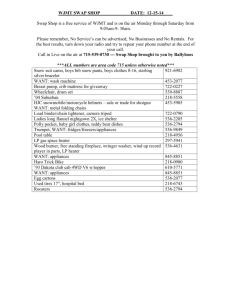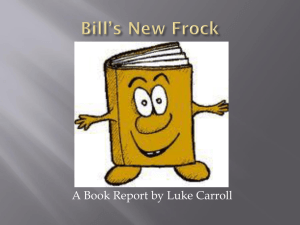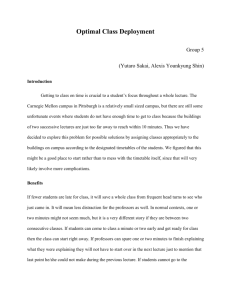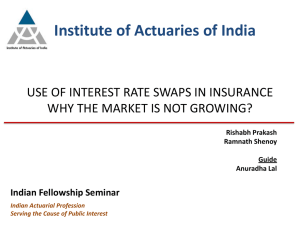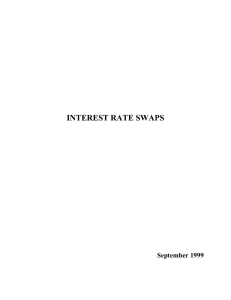Document
advertisement
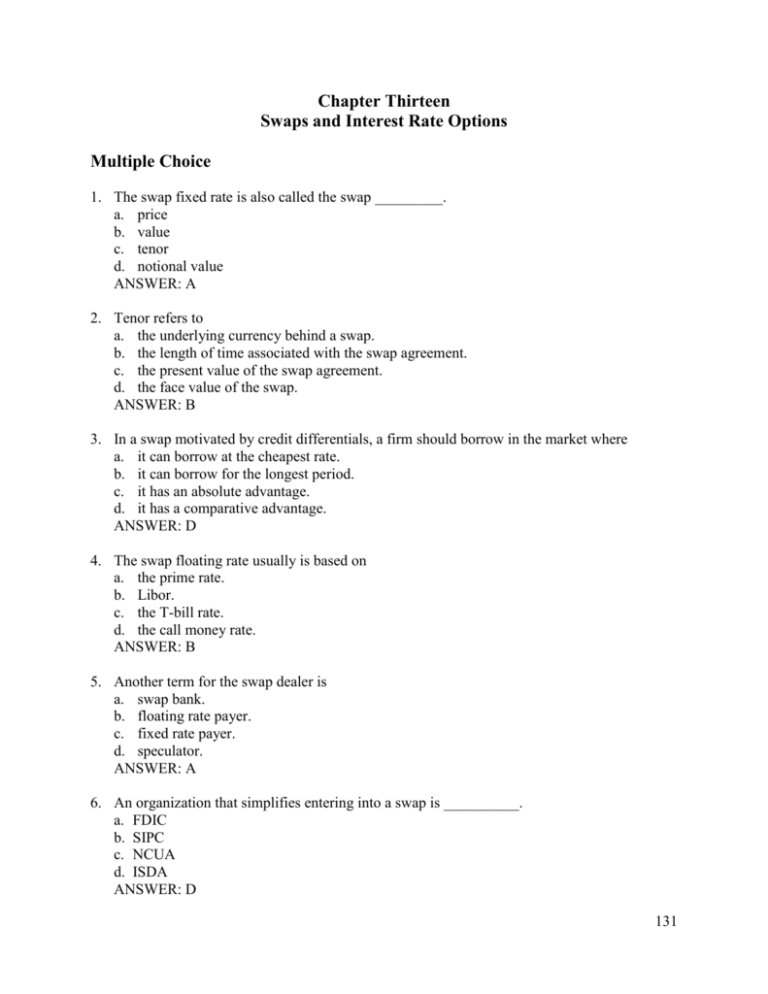
Chapter Thirteen Swaps and Interest Rate Options Multiple Choice 1. The swap fixed rate is also called the swap _________. a. price b. value c. tenor d. notional value ANSWER: A 2. Tenor refers to a. the underlying currency behind a swap. b. the length of time associated with the swap agreement. c. the present value of the swap agreement. d. the face value of the swap. ANSWER: B 3. In a swap motivated by credit differentials, a firm should borrow in the market where a. it can borrow at the cheapest rate. b. it can borrow for the longest period. c. it has an absolute advantage. d. it has a comparative advantage. ANSWER: D 4. The swap floating rate usually is based on a. the prime rate. b. Libor. c. the T-bill rate. d. the call money rate. ANSWER: B 5. Another term for the swap dealer is a. swap bank. b. floating rate payer. c. fixed rate payer. d. speculator. ANSWER: A 6. An organization that simplifies entering into a swap is __________. a. FDIC b. SIPC c. NCUA d. ISDA ANSWER: D 131 Chapter 13. Swaps and Interest Rate Options 7. Which of the following is most correct? a. The fixed rate payer always remits a check. b. The floating rate payer always remits a check. c. Both parties always remit a check. d. One party remits a difference check. ANSWER: D 8. The size of the interest rate payment depends on a. the notional value. b. the tenor of the swap. c. the credit risk of the parties involved. d. the swap value. ANSWER: A 9. A type of risk inherent in swaps that is not inherent in listed options is a. market risk. b. counterparty risk. c. the risk of a price decline. d. the risk of a price rise. ANSWER: B 10. Regarding interest rate swaps, all of the following are true except a. you may either pay or receive the floating rate. b. you may either pay or receive the fixed rate. c. the principal changes hands at the beginning of the swap. d. interest may be determined in advance or in arrears. ANSWER: C 11. The difference in borrowing rates between two firms is the _____ spread. a. quality b. comparative c. absolute d. market ANSWER: A 12. Which of the following is true regarding foreign currency swaps? a. Principal changes hands at the beginning of the swap only. b. Principal changes hands at the end of the swap only. c. Principal changes hands at the beginning and end of the swap. d. Principal does not change hands. ANSWER: C 132 Chapter 13. Swaps and Interest Rate Options 13. A popular combination of two swaps is a _____ swap. a. CIRCUS b. CLOWN c. DERBY d. MUTUAL ANSWER: A 14. A deferred swap is also called a _____ swap. a. amortizing b. accreting c. floating for floating d. forward start ANSWER: D 15. An interest rate cap is similar to a a. call option. b. put option. c. hedge wrapper. d. covered call. ANSWER: A 16. An interest rate cap is composed of a. accreting swaps. b. amortizing swaps. c. caplets. d. priority claims. ANSWER: C 17. A long cap has a payoff diagram similar to that of a a. covered call. b. long put. c. short call. d. long call. ANSWER: D 18. A long floor has a payoff diagram similar to that of a a. covered call. b. long put. c. short call. d. long call. ANSWER: B 133 Chapter 13. Swaps and Interest Rate Options 19. An option on a swap is a ________. a. swaption b. caplet c. floorlet d. swaplet ANSWER: A 20. A swaption involves a __________. a. good faith deposit b. downpayment c. premium d. short sale ANSWER: C Short Answer/Problem 2. A bank is currently receiving a floating rate on an investment in a yen-denominated loan. The bank wishes to convert these cash flows into floating U.S. dollar receipts. Using “block and arrow” diagrams (like the start below), show how the bank can accomplish this using plain vanilla interest rate and/or currency swaps. Be sure to completely enumerate the associated cash flows. Floating yen Bank Other party Initially Floating yen Bank Bank OP $ principal Yen principal Swap dealer At Origination Floating yen Swap dealer Bank Fixed $ Bank Bank 134 Fixed $ Floating $ $ Principal Yen principal Swap dealer Swap dealer Each Settlement Date At Maturity Chapter 13. Swaps and Interest Rate Options 1. Explain how someone currently involved in an interest rate swap might logically use a swaption along with it. ANSWER: Someone currently involved in a swap might believe that interest rates are going to remain stable for the duration of the swap. In such a case it might make sense to sell a swaption and earn the premium income, expecting that the swaption will expire unexercised. 2. Two firms have the borrowing rates shown below. As the CFO of firm AAA, you always consider an interest rate swap before borrowing money. Explain how, if at all, a swap with BBB be advantageous to you if a. you wanted to borrow at a fixed rate. b. you wanted to borrow at a floating rate. Firm AAA BBB Fixed Rate 5 yr T-bond + 60 bp 5 yr T-bond + 75 bp Floating Rate LIBOR LIBOR + 30 bp ANSWER: Firm AAA pays 15 basis points less than BBB in the fixed rate market and 30 basis points less than BBB in the floating rate market. Therefore, AAA has a comparative advantage in the floating rate market. a) The diagram below shows one advantageous arrangement in which AAA and BBB enter into a fixed for floating swap. 5 YR + 60 bp AAA Libor + 10 bp Libor Net: 5 YR + 50 bp BBB 5 YR + 75 bp Net: Libor + 25 bp In this scenario AAA winds up paying a fixed rate that is 10 basis points lower than its market rate, while BBB pays a net rate 5 bp less than its market rate. b) If AAA wants to borrow at a floating rate, there is no obvious advantage to a swap with BBB. AAA’s rate is below BBB’s. 3. In Problem 3, explain firm AAA’s comparative and absolute advantages in the fixed and floating rate markets relative to firm BBB. 135 Chapter 13. Swaps and Interest Rate Options ANSWER: Because AAA pays less than BBB in both the floating and fixed rate markets, AAA has an absolute advantage in both. AAA has a comparative advantage in the floating rate market as the table below shows. AAA BBB Difference 136 Fixed Rate 5 Yr + 60 bp 5 Yr + 75 bp 15 basis points Floating Rate Libor Libor + 30 bp 30 basis points

